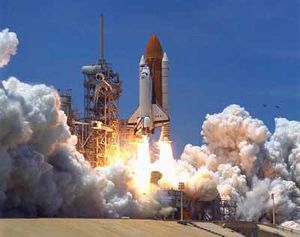UnNews:NASA Baffled by Failure of Straw Shuttle
Florida -- NASA officials watched in horror Monday as the $68 billion straw space shuttle, Explorer 2, burst into flames just after liftoff from Cape Canaveral.
The four American and three Russian astronauts onboard were killed instantly, despite their protective all-straw space suits. Technicians were stunned by the failure, which capped a flawless six-month pre-launch test period. They count faulty twine among the possible causes of the accident.
"The straw ship was dry, light-weight and well-bailed enough to break the earth's orbit, but inexplicably burst into flames when ignited with 3,000 gallons of rocket fuel," said NASA Chief Engineer George Toshikima. "This is a devastating setback for NASA."
An estimated 30 birds, eight voles and 23 mice who had nested in the ship's outer hull or burrowed homes deep in the ship's straw engines also perished in the blast.
The material holding the ship in place was top-quality burlap bailing twine, purchased in bulk from Cape Canaveral's leading farm equipment supplier.
The straw ship was constructed with over 200,000 bales of U.S. Grade E straw, baled, tied and pitched from NASA's Cape Canaveral farm, and stored over the planting season in the launchpad barn.
"It was nice and crisp and dry," Toshikima said. "Which is the best condition for straw headed away from the earth's gravitational pull."
According to accident reports, the one-eighth-inch thick string was possibly not tied tightly enough or not weaved correctly around a critical fuel-delivery gasket, which may have caused the ship to unravel.
Toshikima does not believe such a small imperfection could have caused the massive explosion. "We are still trying to determine why it suddenly burst into flames," he said. "In all the pre-fueling tests, the procedure went perfectly, but as soon as we ignited the fuel, it exploded. Why?"
Some insiders fault a problem that occurred last week, when a section of the ship's starboard high-pressure re-entry tiles was eaten by a horse.
"The horse should not have been on the launchpad," NASA grounds coordinator Nathan Meersen said. "He ate a critical section of the ship, and it set us back one full day to re-bale and re-tie that section."
Meersen said the horse was returned to NASA stables and given a suitable meal, remnants from the department's long-abandoned, all-hay Mars probe.
Although some reports indicate goats may have gnawed at the ship's exterior cables, NASA scientists maintain that there was never a problem with goats.
Explorer 1, NASA's first straw ship, was built in 1994, but after 11 months of painstaking preparation, it was destroyed the day before the launch when it unexpectedly rained.
The Explorer 2, like its predecessor, was headed for the sun, where it was to be the first spacecraft to land on a star.
"We'd hoped to bring back and study sun rock," Toshikima said.
The straw ship had been equipped with a special reinforced-wicker basket to hold the sun lava for its journey back to Earth. A straw-enforced robot arm was constructed to scoop the lava, which is reportedly as hot as the center of a nuclear holocaust, and place it into the wicker basket.
The ship's debris is slated to be used as mulch.
